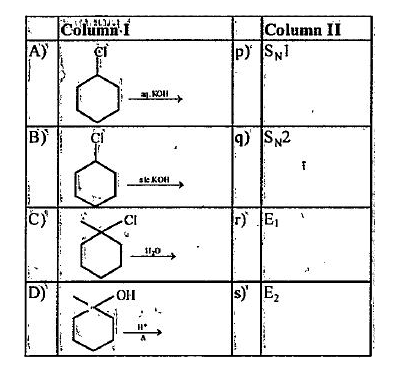Statement 1 : Heterolytic fission occurs readily in polar covalent bonds.
Statement 2 : Heterolytic fission involves breaking of bond in such a way that the shared pair of electron go with one atom.Solution in Malayalam
Statement 1 is True, statement 2 is True, Statement 2 is Correct explanation for Statement 1.
Statement 1 is True, Statement 2 is True, Statement 2 is NOT a correct explanation for Statement 1.
Statement 1 is True, Statement 2 is False.
Statement 1 is False, Statement 2 is True.
The correct Answer is:B
In polar covalent bond, shared pair of eletrons is displaced towards the more electronegative atom and hence in heterolytic fission, the electron pair is easily taken away by more electronegative atom.
Topper's Solved these Questions
- ISOMERISM AND REACTION MECHANISMBOOK - BRILLIANT PUBLICATIONCHAPTER - ISOMERISM AND REACTION MECHANISMEXERCISE - LEVEL - III (Linked Comprehension Type) (Paragraph I)
3 Videos
- ISOMERISM AND REACTION MECHANISMBOOK - BRILLIANT PUBLICATIONCHAPTER - ISOMERISM AND REACTION MECHANISMEXERCISE - LEVEL - III (Linked Comprehension Type) (Paragraph II)
3 Videos
- ISOMERISM AND REACTION MECHANISMBOOK - BRILLIANT PUBLICATIONCHAPTER - ISOMERISM AND REACTION MECHANISMEXERCISE - LEVEL - III (Matching Column Type)
6 Videos
- HYDROGENBOOK - BRILLIANT PUBLICATIONCHAPTER - HYDROGENEXERCISE - LEVEL -III ( Linked Comprehension Type)
8 Videos
- ORGANIC CHEMISTRY : SOME BASIC PRINCIPLES - PART I (NOMENCLATURE) BOOK - BRILLIANT PUBLICATIONCHAPTER - ORGANIC CHEMISTRY : SOME BASIC PRINCIPLES - PART I (NOMENCLATURE) EXERCISE - LEVEL-III
45 Videos
Similar Questions
The leaving group is that functional group which is ejected with electrons of the o-bond in a reaction. Better the leaving group, faster is the reaction. The relative leaving abilitiy of the leaving group X in (R-X) is increased by:
i. The polarisability of (R-X) bond ii. The degree of stabilisation through solvation of X.
iii. The strength of (R-X) bond. iv. The stability of XΘ.
The leaving group tendency is also called fugacity.
Which statement is wrong?
View SolutionStability of carbocations depends upon the electron releasing inductive effect of groups adjacent to positively charged carbon atom involvement of neighbouring groups in hyperconjugation and resonance.
From the following resonance structures of CH3−⋅⋅O⋅⋅−+CH2 predict which of the structures is more stable? : CH−3O−+CH2 , CH3−+O⋅⋅=CH2, CH2=−O⋅⋅−CH3 , All are equally stable
View SolutionMatch the following Column I and Column II :

View SolutionThe volume of 10 volume H2O2, solution that decolourises 200 ml of 2NKMnO4, solution in acidic medium is:
View SolutionGive the IUPAC name of the following compound:

View SolutionHeterolytic fission of a covalent bond in organic molecules gives
View SolutionCovalent bond undergo fission in two different ways. The correct representation involving a heterolytic fission of CH3−Br is
View SolutionAssertion : Heterolytic fission occurs readily in polar covalent bonds.
Reason : Heterolytic fission involves the breaking of bonf in such a way that the shared pair of electrons goes with one atom.
View SolutionConvalent bond can undergo fission in two different ways. The correct representation involving a heterolytic fission of CH3−Br is
View Solution(A) Heterolytic fission involves the breaking of a covalent bond in such a way that both the electrons of the shared pair are carried away by one of tha atoms.
(R) Heterolytic fission occurs readily in polar covalent bonds.
View SolutionCovalent bond can undergo fission in two different ways. The correct represenation involving a heterolytic fission of CH3−Br is
View SolutionAssertion: Heterolytic fission occurs readily in polar covalent bonds. Reason: Hyterolytic fission involves breaking of bond in such a way that the shared pair of electrons go with one atom.
View SolutionIn CH3OH the bond that undergoes heterolytic fission most readily is
View SolutionCorrect statement is :- (1) Homolytic bond fission generates free radicals (2) Carbocation has incomplete octet. (3) If shared electron pair is unequally distributed then it is called heterolytic bond fission. (4) All of these
View SolutionCovalent bond can undergo fission in two different ways. The correct representation involving a heterolytic fission of CH3−Br is
View SolutionConvalent bond can undergo fission in two different ways. The correct representation involving a heterolytic fission of CH3−Br is
View Solution
